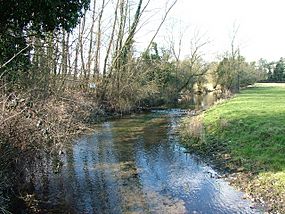River Mimram facts for kids
Quick facts for kids Mimram |
|
|---|---|

The river near Tewin
|
|
| Country | United Kingdom |
| Physical characteristics | |
| Main source | Nr. Whitwell 90 m (300 ft) |
| River mouth | Hertford, Hertfordshire into River Lea 51°47′35.4″N 0°5′16.5″W / 51.793167°N 0.087917°W |
| Length | 20 km (12 mi) |
The River Mimram is a beautiful river located in Hertfordshire, England. It is about 20 kilometers (12 miles) long. This river is special because it is one of the few chalk streams in the world. Chalk streams are rivers that get their water from underground chalk aquifers, which makes their water very clear and clean.
Contents
Where Does the River Mimram Flow?
The River Mimram starts from a spring near Whitwell in North Hertfordshire. A spring is a natural place where underground water flows out of the ground. The river then flows through several villages and areas.
Journey of the Mimram River
The Mimram flows through places like Whitwell, Kimpton Mill, and Codicote Bottom. At Kimpton Mill, another small river called the River Kym joins the Mimram. After this, the river goes through the middle of Welwyn village.
It then flows between the older and newer parts of Digswell. Finally, it travels across the countryside. The Mimram then joins the River Lea near Horn's Mill in Hertford.
Watercress Beds and Springs
Near Whitwell, there are special watercress beds. Watercress is a leafy green plant often used in salads. These beds have been there since Roman times, which is a very long time ago! They are fed by the same clean springs that start the River Mimram.
When the River Gets Longer
Most of the time, the river starts at Whitwell. However, in very wet years, the river can actually extend for several miles further north. This happens because more springs in the upper valley become active and add water to the river. The Mimram Valley is the most eastern valley of the Chiltern Hills.
What Does the Name Mimram Mean?
The name "Mimram" is thought to come from an ancient language called Celtic. Experts believe it's a very old name, but its exact meaning is a bit of a mystery. Some people have wondered if it's connected to a Celtic god, but there's no strong proof for this idea.
Other Names for the River
Historically, the River Mimram was also known as "Maran." Many old maps from the 1800s and early 1900s show both names: "Mimram or Maran." Even up until the 1960s and 1970s, many local people called the area the Maran Valley. There's even an old house from the 1500s in Digswell called "Maran House."
Some people think "Maran" might be linked to the Catuvellauni tribe. These were ancient Celts who lived in Hertfordshire. They might have come from a part of Europe where a main river is called the Marne. However, we don't know for sure if these tribes were directly connected.
How Does the River Mimram Get Crossed?
One of the most famous crossings over the River Mimram is the Welwyn Viaduct in Digswell. A viaduct is like a very long bridge, often with many arches. This viaduct carries the East Coast Main Line, which is a major railway line. It also carries trains that take people to places like Peterborough and Cambridge.

